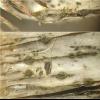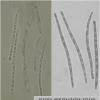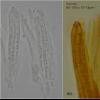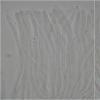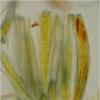
27-10-2025 00:34
 Francois Guay
Francois Guay
I found this strange species in Québec,Canada, gr

27-10-2025 15:29
 Michel Hairaud
Michel Hairaud
Bonjour à tous, Avec Elisabeth Stöckli nous avo

26-10-2025 13:39
Joaquin MartinHi,I found this fungus in a mixed forest of spruce

26-10-2025 21:23
Juuso ÄikäsHello, a couple weeks ago I found some pale, whit

23-10-2025 20:59
Patrice TANCHAUDBonsoir, est-ce que quelqu'un posséderait un com

24-10-2025 14:50
 Riet van Oosten
Riet van Oosten
Hello, Found by Laurens van der Linde, Oct. 2025
I found this ascomycete growing on stem of Equisetum arvense.
0.5 to 1 mm are the measured to ascomata.
The spores have numerous septa (I counted to 11). They have one rounded apex and the other pointed. They are straight or slightly curved.
The paraphyses are multiseptadas, x 2.3-3um wide, and with the apex slightly swollen (to 4um).
Asci and paraphyses present a species of gel that keeps together by the apex.
I do not have a key to the genera of Rhytismataceae, but looking at the literature that I have, I think it could be Naemacyclus. At first I thought of N. caulium but both the spore size as the asci is significantly higher. I've seen that those sizes would fit better with N. lamberti, but I haven't a clear description of the species.
Can anyone help?
a greeting
Susana

The asci are not inamyloid: I see a faint red reaction on the ascus wall. If you view when the Lugol comes in contact with the hymenium then you should see a faint blue front before all turns red.
More instructiv is to pretreat with KOH. Afterwards you will get a blue hymenium.
Equisetum seems a very exceptional substate for the species, but it is actually plurivorous, including ligneous hosts.
Zotto

These Karstenia species are not at all easy, and I feel there are more species hidden behind my images. My drawing Karstenia macer, HB 6113.JPG looks microscopically like yours. The apothecia have black lobes but your fungus is also somewhat dark, isn't it?
So maybe K. macer would be a better choice.
Zotto
Con Karstenia macer encaja perfectamente.
Si, mis ascomas también tienen el margen ennegrecido.
Gracias de nuevo.
Susana

